Introduction
 Regional theatre in India encompasses all the regional flavour of the Indian states. The multilingual aspect of India`s poetic articulation amidst Indian theatre, have been severely appreciated by people around the country. Diverse culture, varied religion and most importantly the multi-dimensional nature of Indian language has played a great role in shaping up India`s rich heritage and culture. The fusion of different Indian language and the union of varied Indian traditions from different region have enriched India`s ethnicity in quite a large way since the remote past. India, as a multilingual and multi religious state can not be allied with one particular kind of trend and aspect in its theatres and dramas. This is the reason why the deep fervor of Bengali theatre has gelled well with the passion of Hindi Manipuri, Kannada and Marathi theatre and has given birth to a whole new concept of "Indian theatre". It is right after the independence of India, Indian theatre in different Indian languages and regions developed as an important element in taking theatre to the further level of maturity.
Regional theatre in India encompasses all the regional flavour of the Indian states. The multilingual aspect of India`s poetic articulation amidst Indian theatre, have been severely appreciated by people around the country. Diverse culture, varied religion and most importantly the multi-dimensional nature of Indian language has played a great role in shaping up India`s rich heritage and culture. The fusion of different Indian language and the union of varied Indian traditions from different region have enriched India`s ethnicity in quite a large way since the remote past. India, as a multilingual and multi religious state can not be allied with one particular kind of trend and aspect in its theatres and dramas. This is the reason why the deep fervor of Bengali theatre has gelled well with the passion of Hindi Manipuri, Kannada and Marathi theatre and has given birth to a whole new concept of "Indian theatre". It is right after the independence of India, Indian theatre in different Indian languages and regions developed as an important element in taking theatre to the further level of maturity.
Malayalam Theatre, Gujarati Theatre, Kannada Theatre all has its roots associated with the British rule as the seed of the contemporary drama in India was sown during that era. Bengali theatre started with an intention of private entertainment however gradually it became the weapon to illustrate the dislikes and frustration of the British imperialism in India. As an art form Bengali theatre has its roots associated with the British Raj. Although started as private entertainment in the early 19th century Bengali theatre gradually became not only an eminent art form but also started playing the major role in illustrating the discomforts of the administration of British Empire in India. The year was 1947 and the day was 15th August - Indian Independence Day.
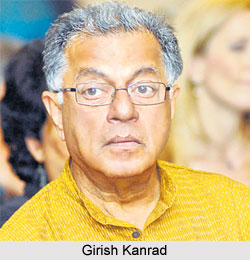 The day is indeed a red letter day in the history of Indian theatre. Not only India stood apart as a socially and politically sovereign state but also Indian culture, art, music, literature all witnessed a colossal change. Theatre and Indian drama, in various regional languages of the state, gradually became an art form, to illustrate the social and political ailments of independent India. Right after the independence of India the communist consolidation and the growth of left ideologies in India specially in West Bengal, used Bengali theatre as a typical means of advertisement or propaganda. Quite ideally, therefore, a new trend in Multi lingual and regional theatre gradually developed and the emergence of the theatre companies in India is one of them. All these theatre groups carried somewhat an ideological belief at the same time as distinct cultural inspiration to differentiate themselves from the typical artistry of the ancient Indian theatre.
The day is indeed a red letter day in the history of Indian theatre. Not only India stood apart as a socially and politically sovereign state but also Indian culture, art, music, literature all witnessed a colossal change. Theatre and Indian drama, in various regional languages of the state, gradually became an art form, to illustrate the social and political ailments of independent India. Right after the independence of India the communist consolidation and the growth of left ideologies in India specially in West Bengal, used Bengali theatre as a typical means of advertisement or propaganda. Quite ideally, therefore, a new trend in Multi lingual and regional theatre gradually developed and the emergence of the theatre companies in India is one of them. All these theatre groups carried somewhat an ideological belief at the same time as distinct cultural inspiration to differentiate themselves from the typical artistry of the ancient Indian theatre.
Multi lingual and regional theatre in India can actually be classified into two distinct streams like the urban theatres and the rural theatres (like tamasha, swang, Jatra etc). This was even particularly common in the classical art form of the Marathi theatre and Hindi theatre. With the thriving development of the various Indian metropolises Marathi, Kannada and Hindi theatre developed in accord to the Bengali theatre. With the direct influence of the "Yakshagana" the ethnic dance drama of Karnataka which offered a distinct shape to the artistry of Marathi and Kannada Theater in the late 19th century. This was the time when Indian drama witnessed the emergence of subtle contrivances and ploys, in illustrating a particular kind of idea. Multi lingual and regional theatre in India, thus for the first time, saw the materialization of allegorical fantasies in farcical comedies. Some more regional languages in which theatre later developed as an important element took this art form to further level of maturity.
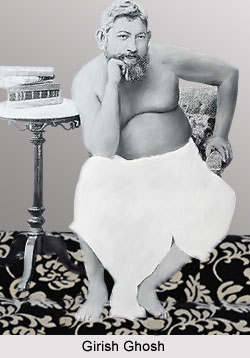 Sindhi Theatre which further popularized the folk art again reshaped the contour of regional theatre in India. With the establishment of the Hyderabad Amateur Dramatic Society in 1912, the change in theme of Sindhi drama became evident. The society`s mainstay, Nanikram Mirchandani, introduced social realism in Sindhi theatre to aid it in befitting the modish aspect of the society. Konkani theatre, Kashmiri Theatre and also the Maithili Theatre witnessed a marked change. Maithili Theatre spread to Assam and Nepal, producing a huge corpus of Maithili drama. Siddhi Narasinghadeva and Bhupatindra Malla were among the known playwrights in Nepal. At the end of the nineteenth century Parse theatre and Ramlila reached Mithila, leading to the premature burial of Kirtaniya. Oriya Theatre blended a deep philosophical meaning with that with the religious fervor to make regional theatre in India to stand out with pride.
Sindhi Theatre which further popularized the folk art again reshaped the contour of regional theatre in India. With the establishment of the Hyderabad Amateur Dramatic Society in 1912, the change in theme of Sindhi drama became evident. The society`s mainstay, Nanikram Mirchandani, introduced social realism in Sindhi theatre to aid it in befitting the modish aspect of the society. Konkani theatre, Kashmiri Theatre and also the Maithili Theatre witnessed a marked change. Maithili Theatre spread to Assam and Nepal, producing a huge corpus of Maithili drama. Siddhi Narasinghadeva and Bhupatindra Malla were among the known playwrights in Nepal. At the end of the nineteenth century Parse theatre and Ramlila reached Mithila, leading to the premature burial of Kirtaniya. Oriya Theatre blended a deep philosophical meaning with that with the religious fervor to make regional theatre in India to stand out with pride.
Development of Assamese Theatre, Dogri Theatre, Manipuri Theatre needs mention in shaping the structure of regional theatre in India. It is with the colors of Rajasthani Theatre, the verve of regional theatre in India gained a dimension. Rajasthani theatre as a popular theatre form was formed in the late nineteenth century. Nepali Theatre, Tamil Theatre, Telugu Theatre, and Urdu Theatre all aided in shaping the Indian regional theatre to a great extent
The journey of the Multi lingual and regional theatre in India thus unfolds Indian natural history of British period and the independence of India. It is the saga of a changing trend; the account of an altering pattern which made Indian theatre lot more contemporary with its entire sophistication and modishness.
Regional Theatre in Western India
Regional Theatre in Western India speaks in volume the theatre of Rajasthan, Bombay and the western states of India. Rajasthani language was spoken in the north-western state of Rajasthan. This is supposedly the ancient language of the eighth century. But as a matter of fact it did not develop any theatrical traditions apart from folk styles away from the courts, such as Khyal, Tamasha, or Rasdhari, and puppetry famous as Kathputli. Only as late as 1900, Rajasthani drama came into existence under the influence of Parsi theatre.
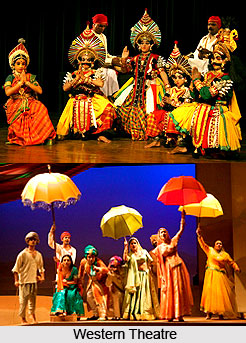 The beginning of the twentieth century brought in the era of social reforms and the national movement. Many social and historical plays written for the Parsi theatre became very popular. Some were banned and the playwrights imprisoned by the British government. Taking the cue from Parsi theatre, authors writing novels and short stories in Rajasthani also took to theatre. They thought it as a powerful weapon of propaganda against social and political evils. Through their plays, they tried to force society to react and eradicate these problems. Shiv Charan Bhartiya, who was the first Rajasthani dramatist, published Kesarvilas in 1900.
The beginning of the twentieth century brought in the era of social reforms and the national movement. Many social and historical plays written for the Parsi theatre became very popular. Some were banned and the playwrights imprisoned by the British government. Taking the cue from Parsi theatre, authors writing novels and short stories in Rajasthani also took to theatre. They thought it as a powerful weapon of propaganda against social and political evils. Through their plays, they tried to force society to react and eradicate these problems. Shiv Charan Bhartiya, who was the first Rajasthani dramatist, published Kesarvilas in 1900.
This was followed by Budhapa ki sagai i.e. `Old-age Betrothal` in 1906 and Phataka janjal or `Snare of Future Trade` in 1907. In his introduction to Phataka janjal, Bhartiya wrote that his main aim was to show social evils to the Rajasthani people. Bhagwati Prasad Daruka wrote Vriddh vivah natak i.e. `Play of Elders` Marriage` in 1903, dealing with old men wedding young girls, and Bal vivah natak i.e. `Play of Child Marriage` in 1918. Other notable plays included Gulab Chand Nagauris Marivadi mausar aur sagai janjal i.e. `Rituals of the Dead and Snares of Betrothal` in 1923 and Balkrishna Lahoti`s Kanya bikri i.e. `Sale of Girls` in 1938.
Narayandas Agarwal made an interesting experiment in Maharana Pratap in 1924, where different characters delivered their dialogue in their own languages. The examples can be given as Maharaja Prithiviraj spoke the dialect of Bikaner, Akbar spoke in Persianized Urdu, Maharana Pratap and his courtiers in Mewari, and the Bhils who formed the core of Pratap`s army used their tribal language.
Marathi drama and theatre are active in form from the middle of the 19th century and it is continuing till date the folk arts of Maharashtra being the backbone of its cultural ethos Maharashtra thrives to be the melting pot of several poles apart contradictory yet harmonious identities. Medieval India witnessed overseas invasion, the silhouette of the same falling obliquely on Indian theatre chiefly Marathi theatre. Apart from the consolidation of a different territory Marathi glorious history can be traced back to several times, Maharashtra even indulging in the linguistic freedom.
After Bengali theatre in India, Marathi drama is indeed a pivotal break through, the Marathi culture oozing throughout. Marathi Theatre is an art form considered to be very rich aspect in Indian culture. Marathi theatre rose in full swing in Pune and Mumbai, with the inception of dramas by Vishnupath Bhave, who used amorous and tragic themes. Bhave specialized in light hearted farcical themes; comically slaughtering the contemporary social developments providing a conducive platform to the upcoming good work. Sangeet Shrada is rightly the pioneer of social Marathi drama, intoxicating with its artistic and progressive focal points.
Influenced by Yakshagana, the traditional dance drama of rural Karnataka, the Marathi drama achieved a clear regional form by the middle of the 19th century. Marathi theatre at first was more of an untried experimental theatre derived from the folk forms and the already breathing Shakespearean and Parsi dramas. `Natak Companies` were then floated, with an addition of the Hindustani classical music and dance in Marathi plays that were replete with mythological and social themes, which became popular instantly. Even historical plays about the famous Marathi heroes like Shivaji and others, began to be written and presented. As these were banned, the Marathi dramatists invented subtle stratagems to present their point of view in allegorical fantasies or in farcical comedies.
Humorous social plays came later which gradually became a speciality of Marathi stage. A leading contemporary dramatist, Mama Varerkar wrote social plays in a realistic style, attempting a synthesis between European convention and Indian content. He gave a tremendous lead to the younger groups, which have been re-creating the Maharashtra village theatre through the Powada and the Tamasha. Years between the time gap1885-1920 were productive enough in terms of quality and the quantity of the plays and a delight for theatre connoisseurs.
Gujarati theatre has a rich history and tradition with prosperous tradition of writing and performing Sanskrit theatre till the fourteenth century, when a folksinger of religious narratives, Asaita Thakar, start on a participatory form called Bhavai using mythological and historical themes and characters, creating awareness among audiences on social issues. Types of Gujarati theatre is more than 150 years old and has produced many actors, directors and writers with tremendous talents.
Naath Theatre: Kamlesh Mota and Babul Bhavsar established this in 1992 with an aim to provide a message to the masses while entertaining them through the plays. This Gujarati theatre in Mumbai presents regular Hindi and Gujarati plays. It is also associated with the premier institution of art "Sangeet Kala Kendra". The plays of this theatre are staged in the UAE and East Africa. The most prestigious play by Naath Theatre is "Saraswati Chandra", which won five awards by the Transmedia Software Private Limited in the year 2003-04`.
Ideas Unlimited: This theatre has promoted the Gujarati literature and culture to a wider audience. It tries to create an interest and appreciation of the rich Gujarati cultural heritage among the young generation through theatre. It is considered as the only Gujarati theatre group in the city, which is modern in sensibility.
Kala Sangam: It is one of the most talent creator Gujarati theatre group in Mumbai.
Parsi theatre was highly influential in 1850s and 1930s. Parsi Theatre can be seen as India`s first modern commercial theatre. It was an aggregate of European techniques, pageantry, and local forms, enormously successful in the subcontinent. As the name indicates, it was subsidized to a great extent by Parsis. Parsis were mainly engaged in trading and shipbuilding. They eventually became an important business force on the west coast by the early nineteenth century, and began to cultivate the arts and philanthropy. A Parsi, Sir Jamsetjee Jeejeebhoy, bought the colonial Bombay Theatre in 1835. In 1846 the Grant Road Theatre in Bombay, constructed by Jagannath Sunkersett began hosting plays in English, then in Marathi, Gujarati, and Urdu or Hindi.
The first Parsi production is normally dated to October 1853, by the Parsee Stage Players at Grant Road Theatre. Beginning as amateur groups that soon turned professional, many new troupes were launched in this period of rapid expansion when audiences grew large, made up mostly of Bombay`s middle class. Major ones included the Parsee Stage Players, Victoria Theatrical Company, Elphinstone Dramatic Club, Zoroastrian Theatrical Club, Alfred Theatrical Company, Madan Theatres in Calcutta, Empress Victoria Theatrical Company and Shakespeare Natak Mandali. By the 1890s, they employed salaried dramatists and actors. They built their own playhouses, and printed their scripts. They may have had many Parsi financiers, managers, performers, and patrons. But the personnel were by no means exclusively Parsi. Considerable cross-regional and cross-linguistic movement of artists and writers led to a heterogeneous mix at a broadly national level, with the result that Parsi companies not only worked in Gujarati, Urdu, Hindi, and even English, but inspired theatres in virtually every corner of India. This created perhaps the largest ticket-buying audience in Indian stage history. By 1900, troupes had started in Karachi, Lahore, Jodhpur, Agra, Aligarh, Meerut, Lucknow, and Hyderabad. Although Parsi theatre survived till the 1940s and beyond, notably with Fida Hussain in Calcutta, after the 1920s a majority of the companies transformed into movie studios once the Indian cinema industry was inaugurated. Later, with the coming of the talkies i.e. Alam Ara in 1931, most of them either closed down or grew into larger units. But one way or another, Parsi capital sustained at least three major studios namely Imperial Film, Minerva Movie tone, Wadia Movie tone and one distribution network, the Madan Theatres.
Regional Theatre in Central India
Regional theatre in Central India includes the various forms of theatre and plays performed in the Central Indian states of Madhya Pradesh and Chhattisgarh. The origin of these forms of theatre dates back to ancient times and most of them depict different themes in the Hindu epics like Mahabharata.
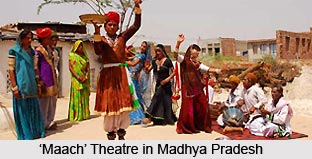 Regional theatre in Madhya Pradesh
Regional theatre in Madhya Pradesh
Madhya Pradesh boasts of different types of theatre which comprises folk theatre as well as the traditional forms of theatre. `Swang` theatre is quite popular in this Indian state, which is also performed in some other Indian states like Uttar Pradesh and Haryana. However, Swang is more focused towards the delivery of dialogues rather than actions and is said to have been born in the early 19th centuries. Amongst the forms of traditional theatre, `Maach` is the most popular one in Madhya Pradesh. The stage as well as the entire drama is termed as Maach. Great emphasis is laid on the songs which are sung in between the dialogues of Maach. The rhyme used in Maach is known as `vanag` while the dialogue used is known as `bol`. `Rangat` is the local name for the tunes of Maach.
Regional Theatre in Chhattisgarh
`Gammat` is the most significant type of theatre which is prevalent in the state of Chattisgarh and `Pandavani` is said to be a lyrical form of Gammat. Numerous renowned plays of the noted theatre director Habib Tanvir, like `Charandas Chor`, are adaptations of this form of theatre. Pandavani is a traditional folk ballad which portrays the tale of the Pandavas and is accompanied with musical instruments. `Vedamati` and `Kapalik` are the two techniques of narration employed in Pandavani. The musical instruments used involve `ektara`, `tambura`, `bells` and `kartal`. This type of theatre avoids any elaborate stage props and instead utilizes the art of mimicry to communicate ideas. In this theatre form, there is a single lead singer who is accompanied by a group of performers who play the harmonium, majira, tabla, dholka and the harmonium.
Maach and Gammat are two of the most celebrated forms of regional theatre which are widely practised in Central India. Different musical instruments are used to make them interesting and all the more entertaining.
Regional Theatre in Eastern India
Regional Theatre in Eastern India encompasses the flavour of the eastern states. The multilingual facet of India`s poetic articulation amidst Indian theatre, have been severely appreciated by people around the country. Diverse is Indian culture so is its array of varied religion and the multi-dimensional nature of Indian language that has successfully played a great role in shaping up India`s rich heritage and culture. The fusion of different Indian language and the union of varied Indian traditions from different region have enriched India`s ethnicity in quite a large way since the remote past. India, as a multilingual and multi religious state can not be allied with one particular kind of trend and aspect in its theatres and dramas. Eastern Indian States are the states of Bengal, Bihar, Orissa and their theatricality is indeed a journey in itself.
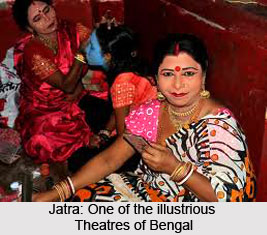 Bengali theatre was initially developed and rather originated as a revolt against the constant autocracy of the administration of British Empire. Regional theatricality in the eastern region manifested with the unfurling of Bengali drama. However as art takes on its course, it later became a major form of art among the people of Bengal. Theatre in Indian under British rule, sowed the seed of contemporaneousness which, gained a rather articulate contour in the hands of the famous theatre personalities if West Bengal like; Girish Ghosh, Bonodini Dasi, Badal Sircar and so on The aim was then to make the mass aware of the then socio political scenario. Quite ideally therefore the playwrights, director and even the actors in Bengali theatre with their unparallel contribution illustrated the colonial fragrance in perhaps the right way. That was the beginning of the journey. It was much later the overall concept of Bengali Theatre as a representation of the age-old British colonialism gradually faded away and theatre became lot more naturalistic. The concept of mirroring the unedited realities of life became so popular within a short span of time that a whole new conception of Realistic theatre in Bengali took place.
Bengali theatre was initially developed and rather originated as a revolt against the constant autocracy of the administration of British Empire. Regional theatricality in the eastern region manifested with the unfurling of Bengali drama. However as art takes on its course, it later became a major form of art among the people of Bengal. Theatre in Indian under British rule, sowed the seed of contemporaneousness which, gained a rather articulate contour in the hands of the famous theatre personalities if West Bengal like; Girish Ghosh, Bonodini Dasi, Badal Sircar and so on The aim was then to make the mass aware of the then socio political scenario. Quite ideally therefore the playwrights, director and even the actors in Bengali theatre with their unparallel contribution illustrated the colonial fragrance in perhaps the right way. That was the beginning of the journey. It was much later the overall concept of Bengali Theatre as a representation of the age-old British colonialism gradually faded away and theatre became lot more naturalistic. The concept of mirroring the unedited realities of life became so popular within a short span of time that a whole new conception of Realistic theatre in Bengali took place.
Bengali plays have a direct connection with Jatras as in the initial days Bengali plays were influenced by the folk plays acted on the open stage. Religion, myths, tradition and customs then were the core theme of the Bengali plays. Bengali plays witnessed a massive change during and after the independence of India. Bahurupi culture in West Bengal also helped in promoting this performing art in a major way. Blessed with its rich heritage, the history of Bengali theatre is the saga of the journey of theatre in Bengal. Started as a naive effort in 1779, Bengali theatre, gradually gained a remarkable dimension whilst sowing the seed of contemporaneousness in Indian drama or theatre. The year was 1795 and it was for the very first time the then intelligentsias of Kolkata witnessed Bengali theatre as the Russian dramatist Horasim Lebedev along with a Bengali theatre connoisseur Goloknath Das staged the Bengali translations of two English comedies, "Disguise" and "Love Is the Best Doctor" in Kolkata. That was the time since when Bengali theatre started its journey. With few unstable steps and later with long strides it was with time, Bengali theatre gained a redefined dimension. By the year 1831 Bengali theatre became a whole new art form to mirror the then Bengal amidst its artistry.
The start of modern Indian theatre can be sketched to constructing of Calcutta Theatre in 1779. In the year 1795, Horasim Lebedev, a Russian dramatist, along with Goloknath Das, a Bengali theatre lover, staged the Bangle translation of two English comedies "Disguise" and "Love is the best doctor" in Kolkata. In 1831, Prasanna Kumar Thankur, set up "Hindu Rangamanch" at Kolkata and also staged Wilson`s English translation of Bhavabhuti`s Sanskrit Theatre "Uttar Ramachiritan" laying the groundwork for modern theatre in India. Other essential efforts on Bengali theatre scene include Jorasanko Natyashala (1854), private theatre stage by Ramsay Basak and Ashutosh Deb (1857), Vidyotshini Mancha (1857), Metropolitan Theatre (1859), Shobhabazar Private Theatrical Society (1865), Bagbazar Amateur Theatre (1868) and Bahubazar Natyashala (1866).
Another rich theatre in the eastern zone is the Assamese Theatre. Assamese theatre boasts of rich and valuable history. There are various types of Assamese theatre which has been composed by reformers of Vaishnava like Madhavadeva and Sankaradeva that have been successfully staged in community halls known as "nam-ghar". There are many modes of performance like Bhaoriya, Dhuliya, and Oja-Pali. Assamese theatre, which first appeared in Guwahati, drew all its initial ingredients from the theatre of western mould with proscenium stage and Anglo-European dramatic structure. This was the forty nine years after the annexation of the state of Assam. The education and exposure to Bengali theatre at Kolkata, during higher studies, inspired many students from new generation into Assamese. This wave occurred in the 19th century and also motivated the youth to make theatre in Assamese language, which became famous instantly and moved entire state of Assam.
The initial years witnessed the growth of Assamese theatre in a grand way, performances in Assamese theatre were held on a temporarily erected stage. Permanent structures came up in the 1890s and with the onset of second decade of 20th century, all sub divisional towns and districts, including semi urban places, had at least one theatre. However, it was neither daily, nor weekly, nor even monthly fare.
Generally plays are performed during important occasions or festivals or just for pleasure of putting up a show. Till this day, apart from the recent touring repertory companies known as Bhramyaman Mancha i.e. "mobile theatre", no group performs daily or weekly on a regular basis. This occurred in spite of the fact that, previously, people made unsuccessful attempts. Yet, there are shows that take place daily, in cultural capital, Guwahati, by one group or the other.
Era of modern social theatre in Assam dawned upon from the year1950. Plays related to social issues were written before 1947, but the number was low. Mostly, playwrights concentrated on, issues related to national awakening and reform against the British rule in India. After India gained independence, playwrights extended their creative horizon into political problems, class struggle, the caste system, conflict between generations, erosion of values, communal tensions, enmity between tribal and non-tribal, unemployment, disintegration of the joint family, hopes and frustrations of the middle class, and individual psychological conflicts. All of the subjects were very modern and contemporary.
One-act play or drama holds a special position in Assamese theatre, and post mid-1950s, actors, writers and playwrights felt attracted to it. It gained immense popularity, during the 1960s, and even overshadowed full-length plays. The modern Assamese theatre also saw the induction of females for plays and acting. They started performing alongside men. The expression for the first phase in theatre after the independence of India mainly dealt with naturalism. Slowly, as the contact established and popularized with the neo-modern playwrights from the rest of India as well as classics by Gogol, Gorky, Ibsen, Chekhov, Sartre, Beckett, Camus, Brecht and Ionesco, novelty in form and content became distinctly visible in the work of Arun Sarma and some more. The current act, in keeping with rest of nation, is to use local folk and traditional forms. The interface of theatre with cinema has also created some star performers, notably Phani Sarma, and creative directors like Dulal Roy etc.
Regional Theatre of North India
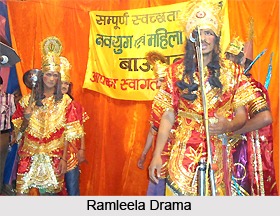 Regional Theatre of North India lays bare the regional streaks of drama within the frame work of Indian cultural scenario. The north Indian states include Haryana, Uttar Pradesh etc. The tradition of folk theatre in Haryana is century`s old, dating back to 16th century. Theatre in Haryana is called the Natya Plays, which is the amalgamation of music, dance, poetry and speech. In Hindu mythology, the gods themselves figure as supreme dancers and Haryana theatre based heavily on mythology. Haryana Drama was created not merely for pleasure but for conveying moral truths, but also to strengthen the cultural integrity. Folk theatre in Haryana is divided into two categories. Firstly, temple based religious theatre, depicting Indian Epics and Puranas and the source material for characters and secondly community-based secular theatre, of minor forms and lighter variety.
Regional Theatre of North India lays bare the regional streaks of drama within the frame work of Indian cultural scenario. The north Indian states include Haryana, Uttar Pradesh etc. The tradition of folk theatre in Haryana is century`s old, dating back to 16th century. Theatre in Haryana is called the Natya Plays, which is the amalgamation of music, dance, poetry and speech. In Hindu mythology, the gods themselves figure as supreme dancers and Haryana theatre based heavily on mythology. Haryana Drama was created not merely for pleasure but for conveying moral truths, but also to strengthen the cultural integrity. Folk theatre in Haryana is divided into two categories. Firstly, temple based religious theatre, depicting Indian Epics and Puranas and the source material for characters and secondly community-based secular theatre, of minor forms and lighter variety.
In reality several themes of Haryana theatre are mixed together with mythological love, popular history and religious themes and different colours of secular values. Haryana Swang follows the old tradition of Haryana, thus being the most popular variety of performance based on the `open stage` technique. The word Sang is the advanced form of Swang, which literally means imitating or disguising. The sang is the rural folk drama in Haryana, which expresses the relationship of love, depicting legendary and modern tales of valour, sacrifice, humour and whatever interests human mind. With a deep-rooted tradition, the Sang in Haryana is based on the open theatre style and in other parts of India, Ramleela and Rasleela are the more popular dramas, based on mythology and religion. It is an all male cultural troupe of Haryana, comprising of twenty to thirty artistes, including the director, producer musicians and actors. Towards the end of the nineteenth century, all women of the Swang troupes performed in western Uttar Pradesh and the adjoining `Khadar `area of Haryana.
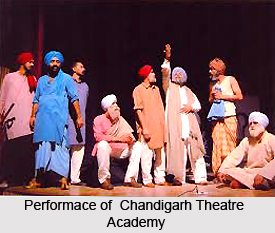
Kashmiri theatre forms an integral part of Kashmiri culture. Having a recorded history that dates back centuries, Kashmiri theatre is an art form rich in content and art. However, Kashmiri theatre has had a rather chequered development, and even though it started off with great pomp and splendour, it witnessed a significant setback in the later stages of its development. Currently, much effort is being made for the revival of Kashmiri theatre.
Kashmiri theatre flourished under royal patronage in the ancient period of Kashmiri history. The ancient golden age of drama in Kashmir lasted 1500 years, commencing from the Christian era right up till the 15th century. Following this flowering of Kashmiri theatre, the medieval period saw a certain stagnation setting in the field of dramatics. Following the 12th century, there were a number of emergent issues that Kashmir had to deal with- invasions, attacks, floods, famines, raids, fires and epidemics. This left little or no time to be devoted to all forms of arts and literature, and resulted in the loss of books, manuscripts and plays. It was during this time that folk theatre continued to survive and made its presence felt in the form of the Bhand Pather. The modern era, with the spread of awareness and education saw a revival of the performing arts and consequently of Kashmiri theatre. Sustained efforts are still being made sustain and develop the field of Kashmiri dramatics.
Punjabi theatre was developed to cater primarily to the urban middle class. The prime intent was to bring about social reform. Whatever the conflicts presented, these plays focused on the domestic and the romantic. The characters were generally stock types, and the climax proceeded on familiar lines. According to Sant Singh Sekhon, Punjabi theatre in its early days was rhetorical, with emotions and sentiments having great importance. Following the partition, the theatre settled in areas like Shimla, Jalandhar, Patiala, Amritsar, Delhi, and, later, Chandigarh. Nowhere could it make its presence felt. In all these places, Punjabi theatre remained a localized affair with no distinctive character of its own.
Later in the 1960`s the regional theatres in different parts attained maturity and professional skill. The National School of Drama, established in Delhi in the early 1960s, became a strong centre for bringing about a purposeful dialogue among theatre folks of the different regions of India. When Punjabi theatre came into contact with the theatre of other regions of India it found a new orientation in Punjab, Delhi and Mumbai.
Regional Theatre of Southern India
Regional Theatre of South India manifests the region based colours of the folk traditions of the south. Malayalam Theatre is of ancient in origin, and is known even though the dramatic literature in Malayalam i.e. the language spoken in southern state of Kerala is of somewhat recent origin. Its oldest extant genre, Kuthiyottam, fully established by the ninth century, may well represent the longest-surviving continuous theatrical tradition in the world. It is a system of staging classical Sanskrit plays, but not entirely Sanskrit theatre in the strict sense because the enactment contains elaborate oral elucidation in Malayalam. Still, it was Kerala`s first performing art based on written texts, and evidently served as a basic model of creative expression for all later forms in Malayalam. Yet it also differs significantly from them in being conventionally presented on raised stages within auditoriums known as Kuttampalam.
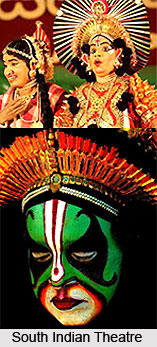 Contemporary Malayalam theatre has a rich heritage behind it, and has indeed come a long way from its past. Just like in any other part of India, Malayalam theatre has also seen a lot of growth in its field. Many theatre enthusiasts and critics felt that the theatre of Kerala did not yield the result as dreamed and expected. Some confusions and perplexity still remain among the people regarding the structure and from of the nature and the medium of production. Some critics are of the opinion that mad experimentation with the themes and plots of the plays have resulted in driving the audiences away.
Contemporary Malayalam theatre has a rich heritage behind it, and has indeed come a long way from its past. Just like in any other part of India, Malayalam theatre has also seen a lot of growth in its field. Many theatre enthusiasts and critics felt that the theatre of Kerala did not yield the result as dreamed and expected. Some confusions and perplexity still remain among the people regarding the structure and from of the nature and the medium of production. Some critics are of the opinion that mad experimentation with the themes and plots of the plays have resulted in driving the audiences away.
Kannada theatre, with all its ancient heritage and rich culture, forms an integral part of the Indian state of Karnataka. Some of the Kannada theatre performances date back to the twelfth century. As far as the folk theatre of Karnataka is concerned, some of the popular folk theatre performances are Yakshagana, Bayalata and Sannata, Talamaddale is a generic variant. The range of theatrical diversity in rural parts of the state also encompasses puppetry. There are two branches, which fall under the term Gombeyata i.e. various forms of ritual possession incorporating worship, such as Bhutaradhane and Karaga. There are also some devotional narratives by and for specific religious sects, as in Kamsale and Viragase.
Tamil theatre is probably the longest linguistic continuity in Indian theatre. With no romanticisation of its ancient origins, one can safely say that remnants and deviations of past traditions find their place in Tamil theatre in different forms. Based on them, one can actually define cultural zones in the southern state of Tamil Nadu by geographical features, occupational aspects, and linguistic clusters. Indeed, ancient Tamil texts classified their land into five regions. These can be mentioned as mountainous, forested, agricultural, coastal and arid.
The ballad traditions have a storyline to offer, the abstract dances have no oral narratives to accompany them, and the narrative forms combine story with performance. Villuppattu and Udukkadippattu are examples of the first, from southern and western Tamil Nadu respectively. In them, local heroes survive and local deities are sung. They contain features that remain on the fringes, not absorbed by any homogenized religious system. Tappattam, Devarattam, Oyilattam, Karagattam, Poykkal Kudhirai, and Kummi belong to the second kind, some with only rhythm and instrumental music, and some with supporting singers. They belong to specific communities following strict feudal orders. The most important among the third category, the thriving Terukkuttu widely prevalent in the northern districts, combines dance, music, plot, dialogue, acting, and costume. Variations can be found in other parts. It is professional in the sense that troupes organize and re-mobilize each year.
Evidence from sculpture and inscriptions indicates that theatrical activities flourished in the present south-eastern state of Andhra Pradesh as early as the second century BC. The Nagarjunakonda excavations laid bare an amphitheatre dated by researchers to the second or third century AD. However, the first definite word of theatre in the Telugu language appears in Palkuriki Somanatha`s poetical texts, Basavapuranamu and Panditaradhya charitramu. He mentions a play, Siriyalu charitra or `Siriyalu`s Story`. This presented with appropriate prelude, correct speech and diction, and proper action during the Sivaratri festival at Srisailam. The only surviving medieval script is Kridabhiramamu or `Graceful Sport` by Vinukonda Vallabharayudu. This was written in the fourteenth century and belongs to the genre of vithi, one of the ten rupakas.
In later days Sanskrit plays were translated in poetic or kavya, but not in dramatic form. However, folk theatre entertained the rural public. During the reign of the Nayaka and Maratha kings based in Thanjavur, Tamil Nadu, Telugu received a boost as their court language. Thus Yakshaganam, which is also called as Vithi Natakam or Bhagavatam, reached its artistic zenith. Tolu Bommalata shadow puppetry, Kuchipudi and Kalapam Voggukatha narrative troupes, Pagati-veshalu, Kuravani dance-drama, Harikatha solo narratives, etc. all these folk forms remained popular for over eight centuries. After the introduction of English education in the nineteenth century, Telugu drama emerged as a distinct literary genre.
It is commonly believed that the first modern Telugu play was Korada Ramachandra Sastry`s Manjari-Madhukariyam i.e. `Tale of Manjari and Madhukara` in 1860. This was a short work with a romantic plot and Sanskritized diction. But no authentic proof exists to validate this claim. The first play may have been Varanasi Dharma Suri`s Narakasura vijaya vyayogamu i.e. `Narakasura`s Victory` in 1871 in the vyayoga genre. This was translated into Telugu by Kokkonda Venkataratnam Pantulu.
Religious Folk Theatre of North India
Religious folk theatre of north India mainly comprised of Ramlila and Raslila narratives. The Nautanki groups of Uttar Pradesh and some of the other groups composed of English speaking Indians and foreigners, tried their best to continue the exclusive practices of the former rulers, providing entertainment both on and off the stage for whoever felt he belonged; their productions were social events more than anything else. The average Indian, whoever he may be, was left out.
Only with the emergence and the vision and energy of directors like Habib Tanvir and Ebrahim Alkazi, and the foundation, of the National School of Drama, in 1959 (whose director Alkazi became in 1962), did a process of experimentation and professionalization start which has since changed the Indian theatrical scene altogether and is still going on. In this process, directors, actors and stage technicians as well as their audiences tried, among other things, to make themselves familiar with non-Indian theatrical traditions and practices.
As was to be expected, Western theatre was represented by classics such as ancient Greek tragedy, Shakespeare and Moliere. More than proportionate importance was given, at least in the initial stages, to European turn of the century illusionist drama perhaps because of some fundamental difficulties it presents to Indian students of theatre as opposed to their Western colleagues: it is a variety of drama which, in its theoretical concepts as well as their practical consequences, is quite contrary to Indian theatrical traditions.
Some of the most important Indian plays written and produced in the late 1960s and early 1970s were influence by, if not modelled after, Western illusionist drama. Again, it was for directors like Alkazi and Tanvir to show a way, if not the way out of this dilemma: it led out into the Indian countryside. While the urban theatre seemed to be passing through a phase of stagnation, its rural counterpart (until recently looked down upon by most of the city dwellers) was going strong as usual, as would appear natural in a country about four fifths of whose population live outside the cities.
In the course of the centuries, Indian folk theatre, or traditional Indian theatre, still attract large audiences in their respective regions, Yakshagana in Indian state of Karnataka, Bhavai in Gujarat, Nautanki in Uttar Pradesh, Jatra in West Bengal, or, as a popular variety of religious folk theatre, the annual presentation of the Ramlila, the life and deeds of Lord Rama, incarnation of the Lord Vishnu, all over Northern India.
For quite some time now, such folk theatre forms have had a considerable influence on modern Indian theatre, which has since brought forth a number of important plays in regional folk theatre styles such as Hayavadana by Girish Karnad (whose first major play, Tughlaq and then plays adapted from William Shakespeare), Ghasiram Kotwal by Vijay Tendulkar or Bakri by Sarveshwar Dayal Saksena.
Now, in retrospect, this large-scale borrowing appears to have been most natural, at least in the Indian context, where there has never been a sharp dividing line between classical and folk, elite and mass, popular and commercial forms of art, with the result that in the field of theatre, many of the principles and practices of classical Indian theatre have, as it were, hibernated in regional folk theatre and in the present century come to light even in mass media such as the commercial Hindi film.




















